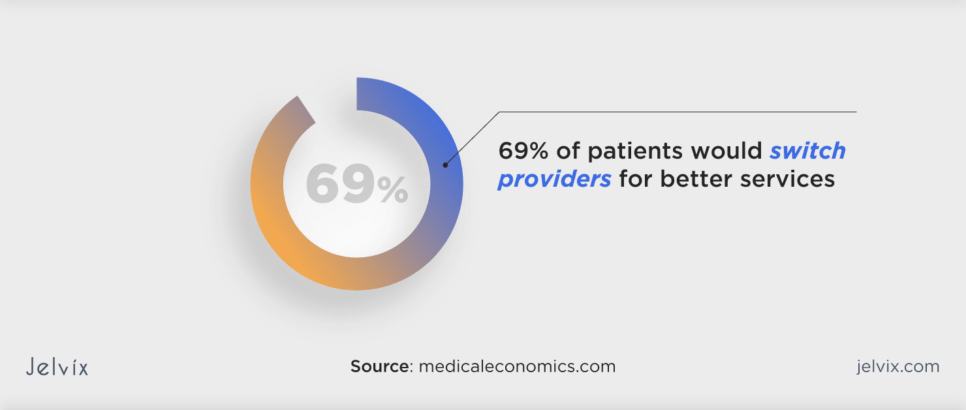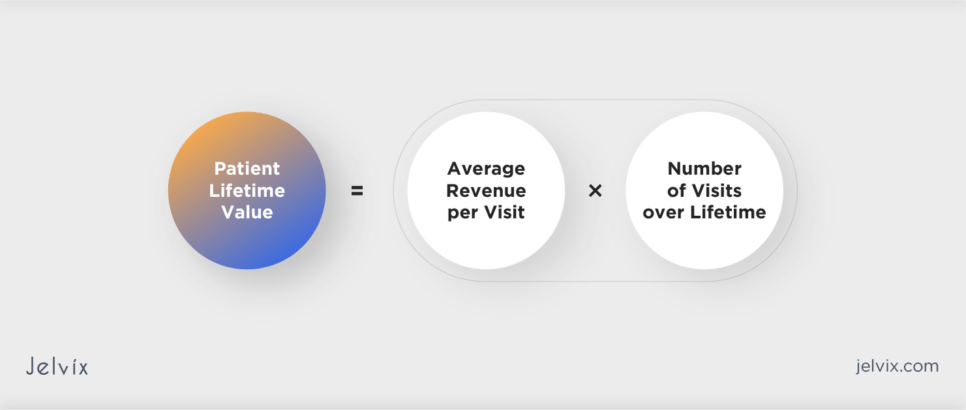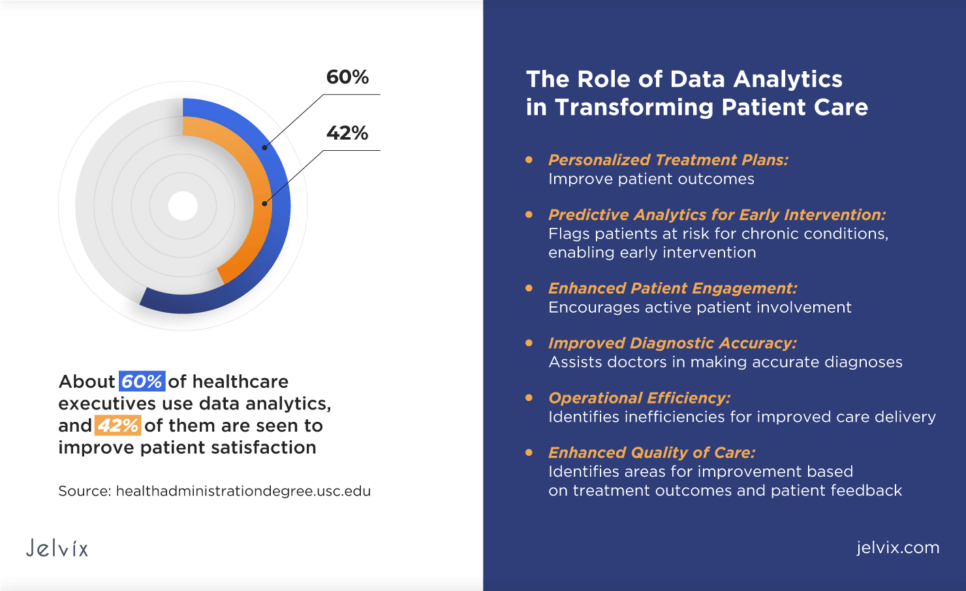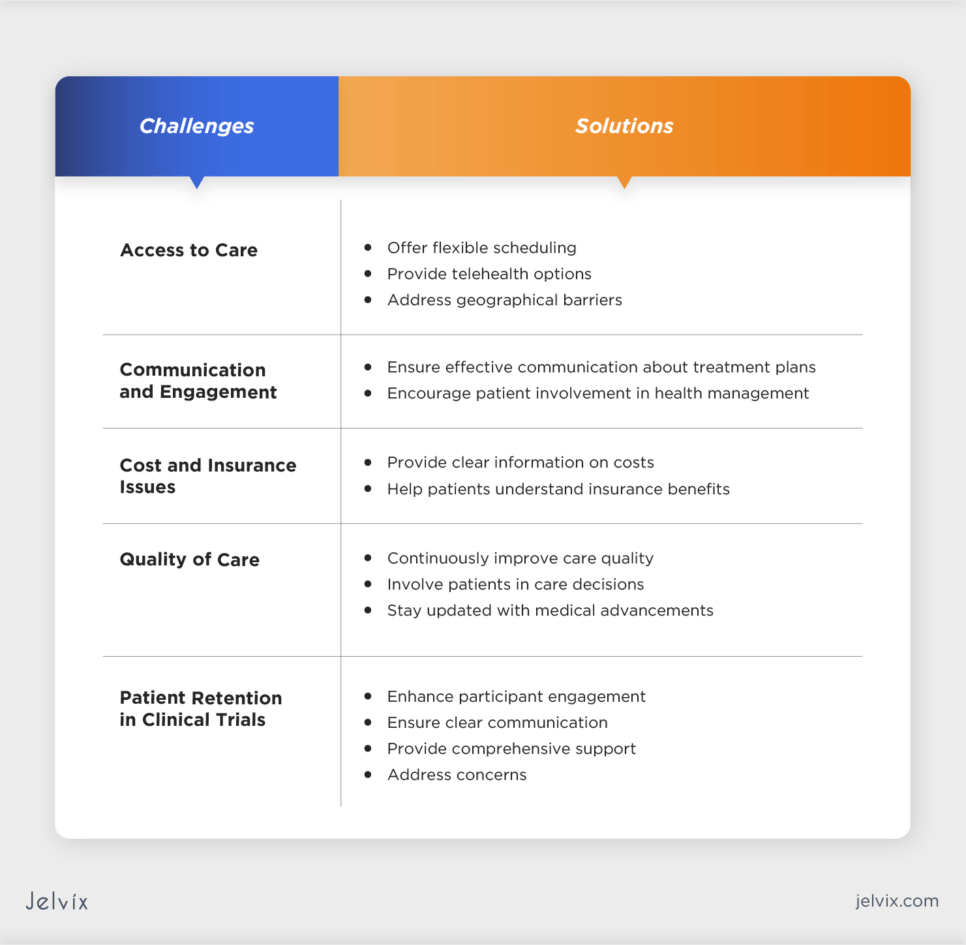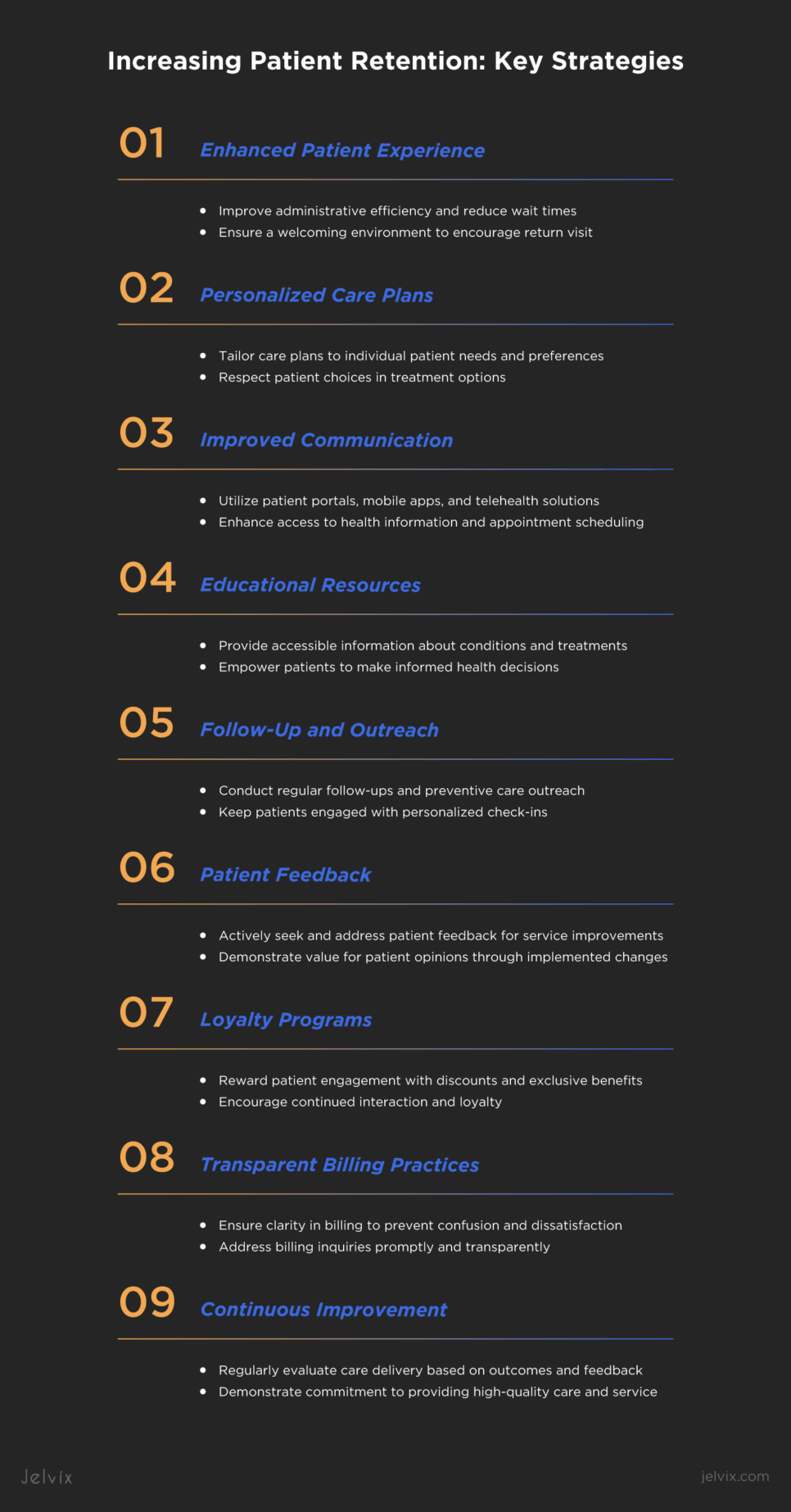As reported by Medical Economics, 69% of patients are ready to switch to another provider to receive better services. As a result, clinics can face potential declines in patient volume and revenue.
Marketing experts often emphasize the importance of retaining existing patients as a strategy for maintaining competitiveness in the healthcare market. Yet, the cost of patient retention initiatives can exceed that of acquiring new patients.
If you seek a healthcare solution that can keep patient engagement on top but won’t make you pay more than you can afford, read this article. You’ll find out how to overcome common challenges in patient retention and discover proven and budget-savvy strategies to keep patients coming back to your clinic.
What Is Patient Retention and Why Is It Important?
Patient retention means maintaining a long-term relationship between healthcare providers and their patients, ensuring they keep choosing the same medical facility over time. It involves creating a positive patient experience that leads to repeated visits and adherence to treatment plans.
Lifetime Value of a Patient
The concept of a patient’s lifetime value (LTV) represents the total revenue a healthcare provider can expect from a single patient throughout their relationship. A higher LTV is associated with longer patient retention. In turn, retained patients contribute to steady revenue streams and reduce the costs associated with acquiring new patients, making patient retention a more cost-effective strategy than patient acquisition.
Understanding Patient Turnover
Patient turnover is the rate at which patients stop their relationship with a healthcare provider. This value can have negative effects on a provider’s stability and reputation. High turnover rates often indicate issues in patient satisfaction, care quality, or communication. Addressing these issues is essential for improving patient care and preventing the loss of revenue.
The lifetime value of a patient underscores the long-term benefits of retention strategies, while an understanding of patient turnover provides the insights needed to address and mitigate factors that drive patients away.
Explore how to develop a patient portal for enhancing patient engagement and optimizing healthcare workflows.
The Financial and Operational Impact of Patient Turnover
Patient turnover can significantly impact both the financial stability and operational efficiency of a healthcare entity. To make sure your healthcare practice is successful and profitable, it is important to understand how patient retention is measured and the dynamics between patient acquisition and retention.
Measuring Patient Retention
Patient retention is measured using key metrics that reflect how effectively a healthcare entity maintains its patient base over time. These metrics provide valuable insights into the effectiveness of retention strategies, guiding efforts to improve patient satisfaction and loyalty.
Calculating Retention Rate
The retention rate is a metric for measuring patient loyalty and satisfaction usually within a specific period. It offers valuable insights into the effectiveness of patient care and engagement strategies. A higher retention rate means a medical company is successful in keeping its patients engaged and satisfied.
The retention rate is calculated using the formula:
Retention Rate (%) = (Ending Customers – New Customers) ÷ Beginning Customers
Where:
- Beginning Customers = number of customers at the start of a period;
- New Customers = number of new customer acquisitions in the current period;
- Ending Customers = number of customers at the end of the period.
This formula provides a clear picture of how well a healthcare entity maintains its existing patient base over a specific period, typically assessed annually.
Calculating Patient Lifetime Value
As you already know, lifetime value estimates the total revenue a healthcare company can expect from a patient throughout the entire duration of their relationship. The simplest way to calculate PLV involves two key factors: the average revenue per visit and the total number of visits a patient makes over their lifetime.
The formula for calculating PLV is the following:
PLV = (Average Revenue per Visit) × (Number of Visits over Lifetime).
For instance, if a medical practice earns an average of $100 per patient visit, and a typical patient visits the clinic once a year for 10 years, the PLV would be:
PLV = ($100) × (10 visits over lifetime) = $1,000.
Note that to make precise calculations, you need to take into account other factors like inflation and the time value of money. What’s more, this formula doesn’t account for the variability in profitability among different patients.
Patient Acquisition vs. Patient Retention
Patient acquisition and patient retention are two fundamental strategies in healthcare management, each impacting the sustainability and growth of medical entities. Understanding the differences between each is needed for effective healthcare management.
Patient Acquisition
It is the process of attracting new patients to a clinic. It involves understanding patient identities (such as demographic information, health needs, preferences, and behaviors) to tailor community outreach strategies and referral programs. The main goal of patient acquisition is to grow the clinic by increasing the number of new patients receiving care.
While acquiring new patients is essential for expanding healthcare services, it often requires significant investment in marketing activities. The cost associated with acquiring a new patient can be considerably higher than retaining an existing one due to the resources needed to build awareness and trust among potential patients.
Patient Retention
As was noted earlier, patient retention focuses on keeping existing patients engaged with the medical entity over time. It helps maintain a stable revenue stream and can be more cost-effective than patient acquisition because retained patients are more likely to come back for additional services and generate new referrals.
Note that to reach better business results, a healthcare company should develop strategies for both acquiring new patients and retaining existing ones.
The Role of Data Analytics in Transforming Patient Care
Data analytics is a powerful tool that can help make patient care more personalized, predictive, and efficient. About 60% of healthcare executives use data analytics, and 42% of them are seen to improve patient satisfaction. As technology advances and more data becomes available, the potential for data analytics to improve care delivery is enormous.
Personalized Treatment Plans
By analyzing patient data, including medical histories and lifestyle reports, healthcare providers can create personalized treatment plans tailored to individual patient needs. This approach improves the effectiveness of patient outcomes.
Predictive Analytics for Early Intervention
Data analytics tools can identify patterns and predict health risks before they become severe. For example, predictive models can flag patients at risk for chronic conditions like diabetes or heart disease, allowing for early intervention and preventative care.
Discover the transformative power of predictive analytics and learn how data-driven insights can enhance patient outcomes.
Enhanced Patient Engagement
Analytics can provide insights into patient behaviors and preferences, enabling healthcare providers to engage patients more actively. Tailored communication strategies and health management plans encourage patients to take an active role in their health care, improving adherence to treatment plans and promoting healthier lifestyles.
Improved Diagnostic Accuracy
Machine learning algorithms can analyze complex medical images, such as MRIs and X-rays, with high precision, assisting doctors in making more accurate diagnoses. This support helps in identifying diseases at earlier stages, leading to better treatment outcomes.
Operational Efficiency
By analyzing data related to patient flow, treatment times, and resource use, healthcare facilities can optimize operations, reduce waiting times, and lower healthcare costs. Analytics can identify the inefficiencies, allowing for improved care delivery processes.
Enhanced Quality of Care
Continuous analysis of treatment outcomes and patient feedback helps healthcare providers identify areas for improvement. Data analytics can highlight best practices and guide evidence-based decision-making, leading to higher quality care and patient satisfaction.
If you are thinking about implementing data analytics tools to improve your clinic’s patient retention rate, reach out to our experts for a consultation. They will provide tech advice based on your actual healthcare needs.
Common Challenges in Patient Retention
Common patient retention challenges include a variety of factors that can influence a patient’s decision to remain with a healthcare provider or seek services elsewhere. Addressing these challenges is required for maintaining a loyal patient base and ensuring the sustainability of healthcare practices.
Access to Care
Patients increasingly value the convenience and accessibility of healthcare services. Challenges such as limited appointment availability, lack of telehealth options, or geographical barriers can limit patients from continuing their care with a chosen provider. Healthcare entities need to adapt by offering flexible scheduling and online consultations with physicians.
Communication and Engagement
Effective communication between patients and doctors is essential for retention. Patients who feel uninformed or disconnected from their care process are less likely to be engaged in their health management. Make sure to provide adequate communication about treatment plans, care follow-ups, and support for any questions and concerns from patients.
Cost and Insurance Issues
Financial considerations play a significant role in patient retention. Unexpected costs, lack of transparency in billing, and changes in a patient’s insurance coverage can lead to dissatisfaction and loss of patients. Providing clear information on costs and working with patients to understand their insurance benefits can help mitigate these concerns.
Quality of Care
Modern patients expect to receive high-quality and evidence-based medical care. Issues such as lack of attentiveness, inadequate treatment outcomes, or disagreements over care plans can contribute to patient turnover. Continuous improvement in care quality, staying updated with medical advancements, and involving patients in care decisions can help clinics retain clients.
Patient Retention in Clinical Trials
Patient retention in clinical trials involves maintaining the participation of enrolled patients from the beginning to the end of a study. High retention rates ensure the validity and reliability of trial results, while dropouts can lead to incomplete data, unreasonable outcomes, and the need for additional recruitment which can increase costs and extend timelines. Effective patient retention strategies in clinical trials should focus on enhancing participant engagement, ensuring clear communication, providing comprehensive support, and addressing any arising concerns timely.
How To Increase Patient Retention: Key Strategies
Improving patient retention is required to build loyalty and increase profits in healthcare entities. The Jelvix team recommends following proven patient retention strategies listed below to improve patient engagement and increase profitability.
Better Patient Experience
Create a welcoming, comfortable, and supportive environment for patients. Improving the overall patient experience is key to retention. Organize the administrative tasks for efficiency, reduce wait times, and make appointments more accessible to impact a patient’s likelihood to return.
Personalized Care Plans
Tailoring care plans to meet individual patient needs shows a deep commitment to their health and well-being. Personalization can include adapting communication styles, considering personal health goals, and respecting patient preferences in treatment options.
Improved Communication
Using patient portals, mobile apps, and telehealth solutions can help enhance communication between patients and doctors. These technologies offer convenient access to health information, appointment scheduling, and secure communication channels that help increase patient engagement and satisfaction.
Educational Resources
Providing patients with accessible information about their conditions and treatments empowers them to actively participate in their care. Educational resources can include digital content, health workshops, and personalized health tips that encourage healthier lifestyle choices.
Follow-Up and Outreach
Regular follow-ups after patient visits demonstrate care beyond the clinical setting. Personalized outreach for preventive care and regular check-ins can keep patients connected and engaged with the clinic, reinforcing their decision to stay.
Patient Feedback
Actively seek and address patient feedback through surveys or direct conversations to show patients their opinions are valued. Implementing changes based on this feedback can lead to service improvements and increased patient satisfaction.
Loyalty Programs
Loyalty programs reward patients for continued engagement with the clinic. Benefits can range from discounts on services to exclusive health sessions, underlying the value of staying with your clinic.
Transparent Billing Practices
Ensuring clarity and transparency in billing practices helps patients understand their financial responsibilities and reduces confusion related to charges. Prompt and clear communication regarding billing inquiries and disputes can help prevent dissatisfaction with medical services.
Continuous Improvement
Regularly evaluating and improving care delivery based on patient outcomes, feedback, and industry best practices can be a good idea. Improvement efforts demonstrate your desire to provide better patient care and service, helping reach a positive reputation and higher patient retention rates.
How Jelvix Can Help You Retain More Patients in 2024
As healthcare continues to change, retaining patients becomes increasingly important for medical entities to ensure sustainability and growth. At Jelvix, we offer innovative digital solutions tailored to the unique needs of healthcare providers to enhance patient retention in 2024.
We are constantly keeping an eye on healthcare technology trends and regulatory changes, developing solutions that help monitor patients’ stats in real-time, offer visits remotely, and use data analytics to improve care outcomes. If you’re in need of various healthcare solutions, get in touch with our team. We specialize in developing and integrating EHRs featuring online support, appointment reminders, and chatbot services to keep patients engaged and workflows optimized. Reach out to our development experts for personalized advice tailored to your current needs and future expectations.
Optimize Your Patient Retention Strategy
Refine your approach to patient retention with customized solutions from our seasoned team.


